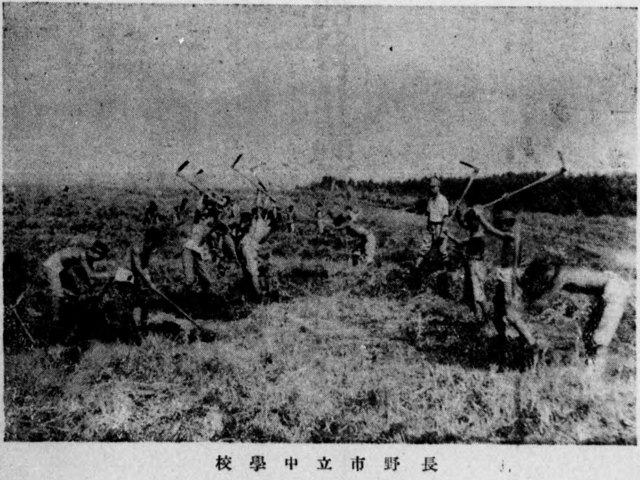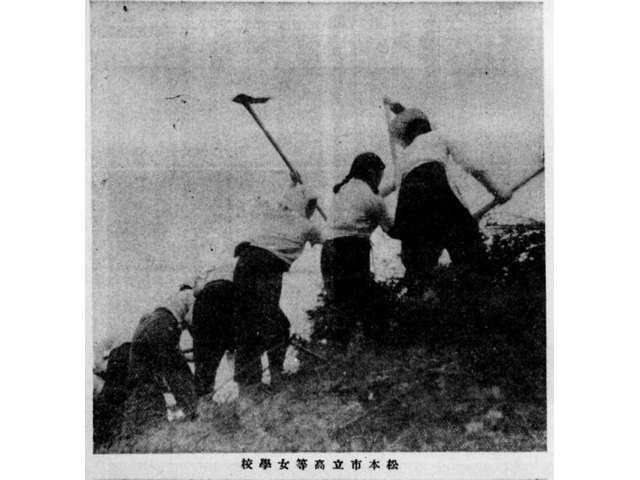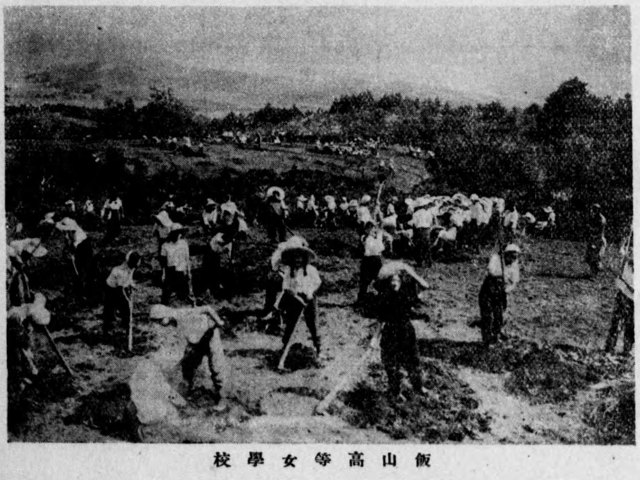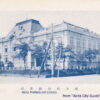“Gakuto Kaikon” (Land cultivation by students)
For researching the 'Nichirin-sha’, I searched the National Diet Library’s digital collection to see if there were any pre-war documents that mentioned the Minami Azumi Agricultural High School farm.
The pre-war name was ‘Minami Azumi Agricultural School’, so I searched there. (Of course, the search was in Japanese.)
There were only four documents that could be seen at home.
Three of these were official gazettes, notifying the approval of the establishment of agricultural schools and the establishment of departments.
The last one was a booklet called ‘Gakuto Kaikon’ means 'Land cultivation by students’.

I think it was part of the student mobilization, but this is the first time I have seen the term ‘Gakuto Kaikon’ used. When I searched for the word, this document from Nagano Prefecture was the only one that came up. Is this a term unique to Nagano Prefecture?
The booklet was published by the Nagano Prefectural Government’s Arable Land Division, First Department of Economics.
Chapter 1: Outline of the plan for the development uncultivated land by the students.
Chapter 2: Guidelines for implementing the student land cultivation project.
Chapter 3: Impressions on student land cultivation.
The contents were as above.
The booklet was published on 22 June 1945, but the actual project was carried out in 1943. It seems to have been compiled afterwards by having students write essays.
The following is an English translation of the implementation guidelines.
Section 1 Boys’ Secondary Schools Undeveloped Land Development Plan
I. Objective
In view of the current situation where self-sufficiency in food is difficult, as an emergency measure, to rapidly cultivate uncultivated land with the cooperation of the school pupils, in order to increase food production and to help the training of the school pupils in mind and body under the decisive battle.
2, Development plan
(1) Area: 300 hectares
(The breakdown by district is as shown in the attached table 1).
(2) Period of implementation
From mid-August to late October 1943
(3) Method of implementation
(a) Project Entity: Each Boys’ Secondary School Patriotism Corps
(b) Mobilization: To be planned separately. As a rule, participants shall stay overnight and bring their own bedding, tableware and food.
(The total manpower required for development is estimated to be 180,000, against which a total of 185,800 persons are expected to be mobilized, with tractors, root cutters and livestock being used in some areas.
(d) Agricultural implements : Among the agricultural implements required for development, the above-mentioned items are currently being planned by the Prefecture. Some cultivating hoes are planned to be purchased, but as much as possible students will be asked to use their own hoes, use equipment from their own schools or temporarily borrow hoes from other sources.
(4) Project budget
Total budget: 202,650 yen, breakdown (project costs: 195,000 yen, office costs: 7,650 yen).
(5) Development guidance
(a) Arable Land Section, Agricultural Administration Section, Education Section
(b) Regional offices
(6) Arable land planning
In principle, each secondary school shall be responsible for the maintenance and management of the developed land.
(7) In accordance with the above, wheat shall be planted this year, and potatoes and other food crops shall be planted from next year onwards, taking fertilisers and labour into consideration according to the speed of development and the conditions of the area.
(The following is an abbreviated list of items only.)
(1) Plan for the use of land under collective cultivation by secondary schools for boys
(2) Plan for obtaining the required seeds
(3) Fertiliser plan
(4) Production plan
(5) Cost budget
(6) Development land management guidance
The word ‘tractor’ is visible in the implementation method, but it is doubtful that it was actually used. The photographs published only show scenes of manual work.

In addition, in the section on arable land planning, it is stated that ‘In principle, each secondary school was responsible for the management of the development land’, so it seems that the schools were also responsible for growing crops.
The separate table listed ‘area by district’ and ‘area by school’, so the area by district is quoted below.
| County/Village/District Name | Range of participating secondary schools | Number of schools | Personnel |
| Minamisaku County: Nobeyamahara in Minamimaki Village | Each schools in Minamisaku County | 3 | 1050 |
| Kitasaku County: Oiwakehara, Karuizawa Town | Each School in Kitasaku County | 6 | 1400 |
| Chiisagata County: Sugadaira, Osa Village | Each school in Ueda City, Chisagata County, Hanishina County, Sarashina County , Kamitakai County | 13 | 3950 |
| Suwa County: Ueharayama, Izumino Village | Each School in Suwa City, Okaya City, Suwa County | 4 | 1150 |
| Kamiina County: (1) Oshibahara, Minami-Minowa Village (2) Ogurogawa and Yokoyama, Ina Town | Each school in Kamiina County | 5 | 1950 |
| Shimoina County: Oyada, Shimojo Village | Each school in Iida City, Shimoina County | 4 | 1580 |
| Nishi-chikuma County: Nishiyama, Kiso Village | Each school in Nishi-Chikuma County | 2 | 600 |
| Minami-Azumi County: Ariakehara, Ariake Village | Each school in Matsumoto City, Higashi-Chikuma County Minami-Azumi and Kita-Azumi County | 11 | 3950 |
| Kami-minochi County: Iizuna-hara,Imoi Village | Each school in Nagano City, Kamiminochi County | 5 | 1900 |
| Shimotakai County: Shiga Kogen, Hirao Village | A schoool in Kamiminochi County, Each school in Shimotakai and Shimominochi County | 4 | 1050 |
| Total 10 districts | 57 | 18580 |
Next to that, a table by school is also included, but as it is not possible to list all of them, I quote part of the table, restricting it to schools in Minami-Azumi County.
| Name of School | Personnel who may attend working | Area size to be developed |
| Matsumoto Middle School | 600 | 80000m2 |
| Matsumoto Daini Middle School | 600 | 80000 |
| Matsumoto Municipal Middle School | 100 | 15000 |
| Matsumoto Commercial School | 600 | 80000 |
| Higashi-chikuma Agricultural School | 450 | 70000 |
| Seibu Agricultural School in Higashi-chikuma | 150 | 20000 |
| Minami-azumi Agricultural School | 450 | 70000 |
| Minami-azumi Sericulture School | 300 | 40000 |
| Hokubu Aguricultural School in Minami-azumi | 100 | 15000 |
| Omachi Middle School | 300 | 40000 |
| Kita-azumi Aguricultural School | 300 | 40000 |
| 11 Schools | 3950 | 550000 |
Similarly, the girls’ plans are also listed and quoted. The title of the girls‘ plan differs from that of the boys’ plan in that it is entitled ‘Patriotic Farm’.

Section 2: Plan for the development Patriotic Farm by the girls’ secondary school.
I. Objective
In view of the current situation where self-sufficiency in food is difficult, as an emergency measure, cultivation of uncultivated land is to be carried out rapidly with the cooperation of the school students, in order to increase food production and to contribute to the mental and physical training of the school students during the war.
2, Development plan
(1) Area: 70 ha
(Breakdown as shown in Annex 1)
(2) Period
From mid-August to late October 1943
(3) Method of implementation
(a) The project shall be conducted by the Secondary Schools’ patriotism corps.
(b) One-day trip.
(c) Equipment shall be used for private use or school equipment.
(4) Project budget
Total budget ¥29,800
Breakdown (project costs ¥28,000, office costs ¥1,800)
(5) Development guidance
(a) Arable Land Section, Agricultural Policy Section, Education Section
(b) Regional offices
3, Cultivation planning
(1) Seeds: Mediated by the Prefecture or Agricultural Association.
(2) Fertilizer: In addition to distributed fertilizer, increase production of self-supplied fertilizer (compost, grass and wood ash) and application of lime.
(3) Production (Omitted)
(4) Development land management budget (Omitted)
(5) Guidance on management of developed land
(a) Agricultural Policy Division, Agriculture and Fisheries Division
(b) Agricultural experiment stations, prefecture agricultural associations, county agricultural associations, regional offices
The girls’ table is by school only, so I don’t quote it, but a total of 51 schools are named in the table. Looking at the owners of the farms covered, not only government-owned and village-owned farms, but also privately-owned farms were included.

This was the only document I could find on the National Diet Library Digital Collections with the notation ‘Gakuto Kaikon’, but I am not sure if this term was only used in Nagano Prefecture.
There is a pre-war ‘Japan News’ video in NHK’s war testimony archive, in which Aomori Prefecture’s land cultivation was in the news. However, this one says that ‘school children and their parents were united in labor service’, so it seems that it was not only the students who worked on the project.
Cultivation work is included in the work of schoolchildren’s mobilization in other prefectures, but I could not find the term ‘Gakuto Kaikon’ in my search.
This is the first time I have heard this term, so I wrote it down anyway as my own recollection.
All photos in the article are taken from ‘Gakuto Kaikon’.
The history of education is summarized on the website of the Ministry of Education, Culture, Sports, Science and Technology (MEXT), which describes how the mobilization system for school pupils was promoted, starting with the ‘Matters concerning the implementation of collective work movement’ in June 1938. The Cabinet decisions included the ‘Guidelines for Establishing a Wartime Mobilization of School Cadets’ (June 1943), the ‘Measures for Wartime Emergency Measures Concerning Education’ (October 1943) and the ‘Outline of Emergency Measures for the Decisive Battle’ (February 1944). The Ministry of Education also issued directives, for example, the ‘Guidelines for the Implementation of Mobilization of Students for Work’ (April 1944) and ‘Guidelines for the Thorough Reinforcement of Student Work’ (July 1944).
In August 1944, the ‘School Cadet Labour Order’ and 'Girls’ Voluntary Service Order’ were promulgated, further reinforcing mobilization.
Then, in March 1945, the Cabinet approved the ‘Guidelines for Decisive War Education Measures’, which went so far as to suspend all school classes from April 1945 to March 1946, except for the elementary courses of national schools.
They finally abandoned secondary and higher education.
[Reference] (written in Japanese)
Digital Collections, National Diet Library, ‘Gakuto Kaikon’.
NHK War Testimony Archive Japan News No. 210 (8 June 1944).
Ministry of Education, Culture, Sports, Science and Technology, 100 Year History of the School System, ‘Progress of the Wartime Education System’.
——
[Postscript] (2023-09-01)
While reviewing past articles, I noticed that the digital collection ‘Gakuto Kaikon’ had somehow been switched to ‘Only within the National Diet Library’. I was able to view it at home when I wrote this article. (That’s why I wrote an article with many quoted parts.)
[Further postscript] (2023-09-02).
I had completely forgotten about it because I did not quote that part of the article at all, but the second half of the booklet contained an essay that the students were asked to write. The reason why it is no longer available to the public may be due to the copyright of each essay.
[Postscript 3] (2024-05-14)
In the first postscript, I wrote that the ‘Gakuto Kaikon’ material was now limited to the National Diet Library, but when I rechecked today, I found that it had been switched to ‘viewable by the transmission service’.







Discussion
New Comments
No comments yet. Be the first one!